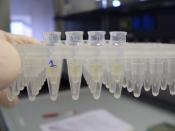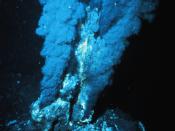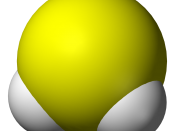Basic study on Chemosynthesis. Good job, maybe a little more on the bacteria
A group of scientists were searching for hydrothermal vents in order to find more
evidence on plate tectonics when they made a startling discovery. Their discovery
revolutionized the way the world is viewed today and destroyed many theories that had
been unchanged for many years! The discovery they made was that there was life thriving
at the bottom of the ocean in a perpetual night! Not just surviving but thriving in a
chemical called hydrogen sulfide that would kill any human, these organisms however are
not breathing the hydrogen sulfide but they are consuming it. The hydrogen sulfide is just
the beginning of what the organisms must put up with just to survive. The tube worms
and clams are living in an environment where the pressure is so great that it could crush a
human in seconds and the temperature so high it could melt titanium.
Originally scientists thought that life could not exist without light because plants
need light to make glucose in a process called photosynthesis. These organisms do not
require light rather they make their food through a process call chemosynthesis.
Chemosynthesis is a process where an organism oxidizes an inorganic compound (in this
case hydrogen sulfide). In this process the inorganic compound supplies the electron since
the oxidizing loses electrons. The electron transport pushes protons through the
membrane producing enough energy to form an ATP .
The tube worms and giant clams (mentioned above) are not the organisms that are
carrying out chemosynthesis. The tube worms have an organ called the trophosome which
contains bacterium, while the clams contain bacterium in their gills. The purpose for the
bacteria is to convert the hydrogen sulfide into a form of energy that can...


